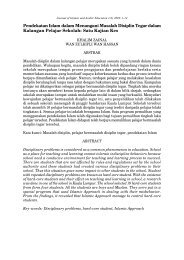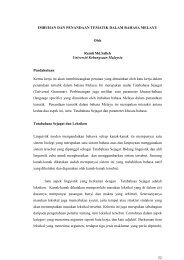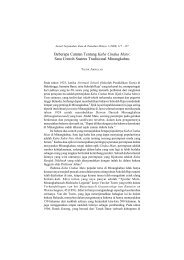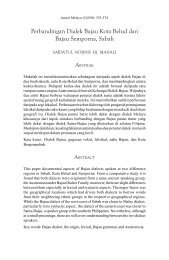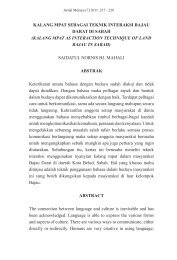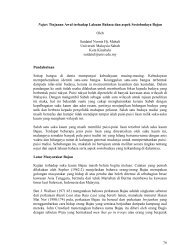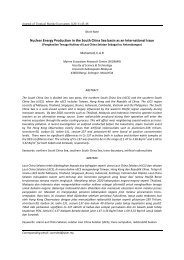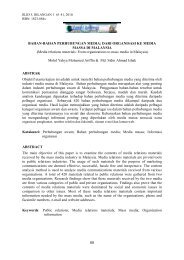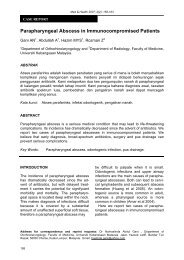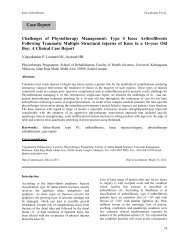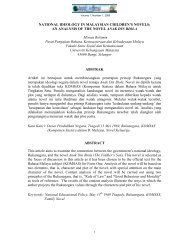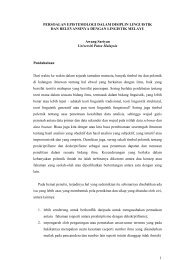Eco Resistance in the Poetry of the Arab - UKM Journal Article ...
Eco Resistance in the Poetry of the Arab - UKM Journal Article ...
Eco Resistance in the Poetry of the Arab - UKM Journal Article ...
You also want an ePaper? Increase the reach of your titles
YUMPU automatically turns print PDFs into web optimized ePapers that Google loves.
3L: The Sou<strong>the</strong>ast Asian <strong>Journal</strong> <strong>of</strong> English Language Studies – Vol 18(1): 75 - 85<br />
<strong>Eco</strong> <strong>Resistance</strong> <strong>in</strong> <strong>the</strong> <strong>Poetry</strong> <strong>of</strong> <strong>the</strong> <strong>Arab</strong> Poet Mahmoud Darwish<br />
HAMOUD YAHYA<br />
School <strong>of</strong> Language Studies and L<strong>in</strong>guistics<br />
FSSK, Universiti Kebangsaan Malaysia, Malaysia<br />
hamoodqaleesi@yahoo.com<br />
ZALINA MOHD LAZIM<br />
School <strong>of</strong> Language Studies and L<strong>in</strong>guistics<br />
FSSK, Universiti Kebangsaan Malaysia, Malaysia<br />
RAVICHANDRAN VENGADASAMY<br />
School <strong>of</strong> Language Studies and L<strong>in</strong>guistics<br />
FSSK, Universiti Kebangsaan Malaysia, Malaysia<br />
ABSTRACT<br />
<strong>Eco</strong>criticism is a new and grow<strong>in</strong>g field and quite a recent phenomenon <strong>in</strong> <strong>the</strong> world <strong>of</strong> literature. This study attempts to<br />
analyze three poems <strong>of</strong> <strong>the</strong> <strong>Arab</strong> poet Mahmoud Darwish us<strong>in</strong>g selected concepts from eco-criticism as a way <strong>of</strong> open<strong>in</strong>g<br />
up this field to <strong>Arab</strong> world academics. The premise <strong>of</strong> this research was impelled by <strong>the</strong> generally agreed view that every<br />
society and culture has <strong>the</strong>ir own way <strong>of</strong> <strong>in</strong>teract<strong>in</strong>g with nature; which <strong>in</strong> turn can illum<strong>in</strong>ate a culture’s worldviews,<br />
norms and values. It can also provide <strong>in</strong>sights as to how nature has been used by certa<strong>in</strong> poets to fur<strong>the</strong>r <strong>the</strong>ir agendas. The<br />
study ma<strong>in</strong>ly dwells on selected poems that have natural objects as <strong>the</strong>ir ma<strong>in</strong> focus and which show how Darwish utilized<br />
nature as a form <strong>of</strong> resistance to colonialism. Such poems <strong>of</strong> Darwish could be used to illustrate how eco-criticism might<br />
contribute to an understand<strong>in</strong>g <strong>of</strong> <strong>Arab</strong> resistance dur<strong>in</strong>g <strong>the</strong> colonialist period. The research shows that <strong>the</strong> <strong>Arab</strong> poet,<br />
Mahmoud Darwish had a special way <strong>of</strong> educat<strong>in</strong>g <strong>Arab</strong> people to resist through “green” poems that were eng<strong>in</strong>eered on<br />
natural environment.<br />
Keywords: eco-criticism; nature; poetry; resistance; Mahmoud Darwish.<br />
INTRODUCTION<br />
<strong>Eco</strong>criticism is fairly a recent phenomenon <strong>in</strong> Literature and Literary Studies. The term ecocriticism<br />
appeared for <strong>the</strong> first time <strong>in</strong> William Rueckert’s essay entitled “Literature and <strong>Eco</strong>logy: An Experiment<br />
<strong>in</strong> <strong>Eco</strong>criticism” <strong>in</strong> 1978. Rueckert argues that any ecological project might identify <strong>the</strong> role <strong>of</strong> nature<br />
<strong>in</strong> a poem, <strong>the</strong> function <strong>of</strong> place/sett<strong>in</strong>g <strong>in</strong> <strong>the</strong> literary work like a novel, land metaphors as gendered<br />
and <strong>the</strong> rhetoric <strong>of</strong> environmental policies. This means that Ruekert‘s approach to ecocriticism focuses<br />
on how to use ecological pr<strong>in</strong>ciples as a model for th<strong>in</strong>k<strong>in</strong>g about how literature functions (Glotfelty<br />
and Fromm 1996). However, ecocriticism rema<strong>in</strong>ed passive <strong>in</strong> <strong>the</strong> critical vocabulary until <strong>the</strong> Western<br />
Literature Association meet<strong>in</strong>g <strong>in</strong> Loeur d’ Alene <strong>in</strong> 1989. Cheryll Glotfelty and Glen Love highlighted<br />
<strong>the</strong> term ecocriticism and called for <strong>the</strong> development <strong>of</strong> environmentally– oriented criticism (Shikha<br />
/ 75
76 \<br />
3L: The Sou<strong>the</strong>ast Asian <strong>Journal</strong> <strong>of</strong> English Language Studies – Vol 18(1): 75 - 85<br />
2011:1-2). From that po<strong>in</strong>t, ecocriticism emerged as a new and grow<strong>in</strong>g literary field <strong>in</strong> North America<br />
and entered rural universities <strong>in</strong> USA <strong>in</strong> <strong>the</strong> 1980s and reached Brita<strong>in</strong> <strong>in</strong> <strong>the</strong> 1990s.<br />
Over <strong>the</strong> last three decades, it has emerged as a field <strong>of</strong> literary study that addresses how<br />
humans relate to nonhuman nature or environment <strong>in</strong> literature (Johnson 2009:7-12). It has also<br />
travelled beyond American and British shores to Africa and India. Accord<strong>in</strong>g to Mwangi (2004:1-3),<br />
African ecocriticism was rarely practiced consciously <strong>in</strong> <strong>the</strong> African Academy although <strong>the</strong> expressions<br />
like ‘man’s struggle “with <strong>the</strong> environment” is <strong>of</strong>ten heard <strong>in</strong> literary essays. In India, <strong>the</strong>re is an<br />
<strong>in</strong>creas<strong>in</strong>g body <strong>of</strong> work that marries postcolonialism and ecocriticism “by analyz<strong>in</strong>g <strong>the</strong> texts that<br />
depict a range <strong>of</strong> engagements with <strong>the</strong> environment and that complicates and extends <strong>the</strong> notion <strong>of</strong><br />
place-connectedness” (Shikha 2011:7).<br />
In <strong>Arab</strong>ic literature, ecocriticism is still <strong>in</strong> its <strong>in</strong>fancy and we th<strong>in</strong>k that it could become more<br />
energetic because most <strong>of</strong> <strong>Arab</strong>ic literature has a rural sett<strong>in</strong>g. From our po<strong>in</strong>t <strong>of</strong> view, most <strong>of</strong> <strong>the</strong><br />
literary works written dur<strong>in</strong>g <strong>the</strong> postcolonial period express <strong>the</strong> <strong>in</strong>tense relationship between <strong>the</strong> <strong>Arab</strong><br />
literary writers and <strong>the</strong>ir homeland from which <strong>the</strong>y get <strong>the</strong> spirit and <strong>in</strong>spiration to resist <strong>the</strong> colonizers.<br />
Among <strong>the</strong>se <strong>Arab</strong> literary works, poetry and poets were present and took a vital role <strong>in</strong> resist<strong>in</strong>g<br />
colonization dur<strong>in</strong>g <strong>the</strong> period <strong>of</strong> <strong>the</strong> western colonialism <strong>of</strong> <strong>the</strong> <strong>Arab</strong> world. This k<strong>in</strong>d <strong>of</strong> resistance<br />
was depicted <strong>in</strong> a number <strong>of</strong> poems <strong>in</strong> which <strong>the</strong> poets employ <strong>the</strong>ir environment <strong>in</strong> terms <strong>of</strong> nature<br />
and its various aspects such as <strong>the</strong> rocks, <strong>the</strong> stones, <strong>the</strong> sun, <strong>the</strong> sea, <strong>the</strong> birds, and <strong>the</strong> hills and so on<br />
to express <strong>the</strong>ir deep outburst <strong>of</strong> resistance. The current study is motivated by this k<strong>in</strong>d <strong>of</strong> resistance<br />
that has been mirrored <strong>in</strong> <strong>the</strong> <strong>Arab</strong> poetry <strong>of</strong> <strong>the</strong> late twenty century particularly by <strong>the</strong> Palest<strong>in</strong>ian<br />
poet Mahmoud Darwish (1942-2008), who is regarded as <strong>the</strong> fa<strong>the</strong>r <strong>of</strong> <strong>the</strong> <strong>Arab</strong> poets <strong>of</strong> resistance to<br />
colonialism. The aim <strong>of</strong> <strong>the</strong> current paper, <strong>the</strong>refore, is to apply <strong>the</strong> ecocriticism framework <strong>in</strong> read<strong>in</strong>g<br />
resistance <strong>in</strong> Darwish’s poems.<br />
The <strong>Arab</strong> poet Mahmoud Darwish (1941-2008) was <strong>the</strong> voice <strong>of</strong> <strong>the</strong> <strong>Arab</strong> resistance whose<br />
stark writ<strong>in</strong>g reflected <strong>the</strong> desperation and alienation <strong>of</strong> <strong>the</strong> Palest<strong>in</strong>ian people. He published more than<br />
20 collections <strong>of</strong> poetry, which have been translated <strong>in</strong>to many languages (many <strong>of</strong> <strong>the</strong>m <strong>in</strong>to English),<br />
and was <strong>the</strong> <strong>Arab</strong> world’s best-sell<strong>in</strong>g poet. His poems are embossed <strong>in</strong> <strong>the</strong> hearts <strong>of</strong> millions <strong>of</strong> <strong>Arab</strong>s<br />
and <strong>the</strong> anti-occupation demonstrators <strong>in</strong> <strong>the</strong> streets <strong>of</strong> Ramallah, Damascus and Cairo have shouted<br />
his words. Many have been set to music, <strong>in</strong>clud<strong>in</strong>g “I yearn for my mo<strong>the</strong>r’s bread” (Wedde 2009).<br />
Darwish was born <strong>in</strong> 1941 <strong>in</strong> al Birwa, an <strong>Arab</strong> village <strong>in</strong> <strong>the</strong> Acre region, which became part<br />
<strong>of</strong> <strong>the</strong> new state <strong>of</strong> Israel <strong>in</strong> 1948. His family fled to Lebanon, although <strong>the</strong>y returned <strong>the</strong> follow<strong>in</strong>g<br />
year. Darwish published his first poetry collection, “Asafir bila ajniha” (“W<strong>in</strong>gless Birds”, 1960)<br />
while still a teenager and soon made a reputation as a “poet <strong>of</strong> <strong>the</strong> resistance”. One <strong>of</strong> his best-known<br />
poems was “Identity Card”, with its defiant open<strong>in</strong>g l<strong>in</strong>es “Record! I am an <strong>Arab</strong>/and my identity card<br />
is number fifty thousand”.<br />
Darwish was arrested three times by Israel for recit<strong>in</strong>g “<strong>in</strong>cit<strong>in</strong>g poems” and left for Cairo <strong>in</strong><br />
<strong>the</strong> Seventies. He jo<strong>in</strong>ed <strong>the</strong> ranks <strong>of</strong> <strong>the</strong> Palest<strong>in</strong>e Liberation Organization (<strong>the</strong> PLO) and became<br />
close to its leader Yasser Arafat. In 1987, he was elected to <strong>the</strong> PLO’s executive committee and it was<br />
Darwish who wrote <strong>the</strong> declaration <strong>of</strong> <strong>in</strong>dependence <strong>of</strong> 1988 read out by Arafat when he proclaimed<br />
<strong>the</strong> state <strong>of</strong> Palest<strong>in</strong>e. He returned to live <strong>in</strong> Ramallah after <strong>the</strong> sign<strong>in</strong>g <strong>of</strong> <strong>the</strong> Oslo Accords <strong>in</strong> 1993<br />
between Israel and <strong>the</strong> PLO, but he had expressed his opposition to <strong>the</strong> Accords and left <strong>the</strong> PLO’s<br />
executive committee <strong>in</strong> protest. Many Palest<strong>in</strong>ians criticized him for hav<strong>in</strong>g left his homeland, and he<br />
defended himself by say<strong>in</strong>g that he had served <strong>the</strong> Palest<strong>in</strong>ian cause abroad better than when he was<br />
<strong>in</strong>side. He passed away <strong>in</strong> <strong>the</strong> United States <strong>of</strong> America <strong>in</strong> August 2008.
3L: The Sou<strong>the</strong>ast Asian <strong>Journal</strong> <strong>of</strong> English Language Studies – Vol 18(1): 75 - 85<br />
BRIEF HISTORY OF ARAB RESISTANCE<br />
Before trac<strong>in</strong>g some critical works that have exam<strong>in</strong>ed <strong>the</strong> resistance <strong>in</strong> <strong>Arab</strong> poetry particularly that<br />
<strong>of</strong> Mahmoud Darwish, we need to expla<strong>in</strong> briefly <strong>the</strong> essence <strong>of</strong> resistance <strong>in</strong> <strong>the</strong> <strong>Arab</strong> history. The<br />
twentieth century witnessed a number <strong>of</strong> historical events <strong>in</strong> <strong>the</strong> <strong>Arab</strong> world. Hence, accord<strong>in</strong>g to<br />
(Manqoush, Yus<strong>of</strong> et al. 2011,pp.57 - 58) “<strong>the</strong> different employment <strong>of</strong> history reveals contestations<br />
<strong>of</strong> worldviews which are symptomatic <strong>of</strong> <strong>the</strong> ideological clashes between <strong>the</strong> East and West”. Among<br />
<strong>the</strong>se ideological clashes, which are still carved <strong>in</strong> <strong>the</strong> human <strong>Arab</strong> m<strong>in</strong>ds, was <strong>the</strong> colonization <strong>of</strong><br />
Palest<strong>in</strong>e by Israel with <strong>the</strong> help <strong>of</strong> <strong>the</strong> British Empire <strong>in</strong> 1948. S<strong>in</strong>ce <strong>the</strong>n, <strong>the</strong> colonized <strong>Arab</strong>s <strong>of</strong><br />
Palest<strong>in</strong>e have been struggl<strong>in</strong>g to ga<strong>in</strong> <strong>the</strong>ir <strong>in</strong>dependence.<br />
Their resistance took two forms. The first is armed resistance and <strong>the</strong> second is literary resistance.<br />
In <strong>the</strong> sense <strong>of</strong> <strong>the</strong> former resistance, three wars took place <strong>in</strong> 1948, 1967 and 1973 between <strong>Arab</strong>s<br />
and Israelis. However, <strong>Arab</strong> resistance (both armed and literary) is closely related to <strong>the</strong> Palest<strong>in</strong>ian<br />
movement <strong>of</strong> resistance that can be dated back to 1936. This resistance movement <strong>of</strong> 1936 gave birth<br />
to <strong>the</strong> <strong>Arab</strong> poets <strong>of</strong> resistance such as Mahmoud Darwish and his companions. The first movement<br />
<strong>of</strong> resistance <strong>in</strong> 1936 was an armed one that broke out <strong>in</strong> many areas <strong>of</strong> <strong>the</strong> occupied land <strong>of</strong> Palest<strong>in</strong>e<br />
and it was <strong>the</strong> first battle between <strong>the</strong> resist<strong>in</strong>g <strong>Arab</strong> and <strong>the</strong> British as well as <strong>the</strong> Jewish colonizers.<br />
However, <strong>the</strong> British colonizers could stop it through <strong>the</strong>ir political relationships with <strong>the</strong> <strong>Arab</strong> leaders<br />
at that time as a part <strong>of</strong> <strong>the</strong>ir plan to establish Israel as an <strong>in</strong>dependent country on <strong>the</strong> occupied land<br />
<strong>of</strong> Palest<strong>in</strong>e. One <strong>of</strong> <strong>the</strong> advantages <strong>of</strong> <strong>the</strong> <strong>Arab</strong> armed resistance <strong>in</strong> 1936 was that it evoked <strong>in</strong>tense<br />
feel<strong>in</strong>gs <strong>of</strong> resistance among <strong>Arab</strong>s at <strong>the</strong> time and cont<strong>in</strong>ues down to subsequent <strong>Arab</strong> generations.<br />
1948 witnessed a tragic historical event <strong>in</strong> <strong>Arab</strong> history <strong>in</strong> general and <strong>in</strong> <strong>the</strong> Palest<strong>in</strong>ians<br />
<strong>in</strong> particular; it was <strong>the</strong> year Israel was established on <strong>the</strong> occupied land <strong>of</strong> Palest<strong>in</strong>e after <strong>the</strong> <strong>Arab</strong><br />
armies were defeated. <strong>Arab</strong> resistance rema<strong>in</strong>ed low for several years dur<strong>in</strong>g which <strong>the</strong> <strong>Arab</strong> people <strong>of</strong><br />
Palest<strong>in</strong>e suffered a lot (Al-naqash1969, pp.14- 16).<br />
Although armed resistance was ma<strong>in</strong>ly muted and passive, literary resistance rema<strong>in</strong>ed active.<br />
This means that <strong>the</strong> literary resistance, resistance through literature, was present and <strong>the</strong> <strong>Arab</strong> poets did<br />
not give up <strong>the</strong>ir resistance to <strong>the</strong> colonization <strong>of</strong> <strong>the</strong>ir homelands. Among <strong>the</strong>se <strong>Arab</strong> poets emerged<br />
<strong>the</strong> poet Mahmoud Darwish who is said to have brought <strong>the</strong> resistance revival and is regarded as <strong>the</strong><br />
fa<strong>the</strong>r <strong>of</strong> <strong>the</strong> <strong>Arab</strong> resistance poetry. Accord<strong>in</strong>g to Faysal Darraj (2008, p.57) <strong>the</strong> expression “<strong>the</strong> poet<br />
<strong>of</strong> resistance” has two implications; first <strong>of</strong> an occupied land that awaits liberation, and secondly, a<br />
national ideology that celebrates <strong>the</strong> poetry <strong>of</strong> commitment to <strong>the</strong> liberation <strong>of</strong> Palest<strong>in</strong>e.<br />
RESISTANCE IN ARAB LITERATURE<br />
Accord<strong>in</strong>g to Harlow (1987, p.2), <strong>the</strong> term “resistance” was first applied <strong>in</strong> <strong>the</strong> description <strong>of</strong><br />
Palest<strong>in</strong>ian literature <strong>in</strong> 1966 by <strong>the</strong> Palest<strong>in</strong>ian writer and critic Ghassan Kanafani <strong>in</strong> his study<br />
Literature <strong>of</strong> <strong>Resistance</strong> <strong>in</strong> <strong>the</strong> Occupied Palest<strong>in</strong>e. Kanafani (1987) states that resistance literature<br />
evoked a dist<strong>in</strong>ction between <strong>the</strong> occupied people, those who stayed <strong>in</strong> <strong>the</strong> occupied Palest<strong>in</strong>e, and<br />
<strong>the</strong> people <strong>in</strong> exile. Such literature was seen to be an identifiable and significant accompaniment<br />
to <strong>the</strong> project <strong>of</strong> political, military and social striv<strong>in</strong>g for liberation. Kanafani (1987) claims that no<br />
research is located with<strong>in</strong> resistance literature unless <strong>the</strong> researcher takes part <strong>in</strong> <strong>the</strong> movement itself<br />
<strong>in</strong>side occupied Palest<strong>in</strong>e. Thus, Kanafani has limited <strong>the</strong> study <strong>of</strong> resistance to <strong>the</strong> native Palest<strong>in</strong>e.<br />
His view <strong>of</strong> resistance seems to be wider but he tends to ignore or neglect how nature plays a vital role<br />
<strong>in</strong> support<strong>in</strong>g <strong>the</strong> sense <strong>of</strong> resistance to colonialism <strong>in</strong> <strong>the</strong> <strong>Arab</strong> nation <strong>in</strong> general and <strong>in</strong> Palest<strong>in</strong>ian<br />
generations <strong>in</strong> particular. Yahya Hassan & Noritah Omar (2011, p.118) state that Kanafani himself<br />
is not a writer or a novelist, but a political activist who has co<strong>in</strong>ed <strong>the</strong> term (adab al-muqawamah)<br />
translated as literature <strong>of</strong> resistance.<br />
/ 77
78 \<br />
3L: The Sou<strong>the</strong>ast Asian <strong>Journal</strong> <strong>of</strong> English Language Studies – Vol 18(1): 75 - 85<br />
Undoubtedly, among <strong>the</strong> <strong>Arab</strong> land, Palest<strong>in</strong>e has an exceptionally attractive and fasc<strong>in</strong>at<strong>in</strong>g<br />
nature that has enthralled <strong>the</strong> hearts and m<strong>in</strong>ds <strong>of</strong> all <strong>the</strong> <strong>Arab</strong> poets. The <strong>Arab</strong> poets have approached<br />
this uniqueness <strong>of</strong> nature <strong>of</strong> <strong>the</strong> occupied Palest<strong>in</strong>e differently. Raja Al-naqash (1996, p.167), an <strong>Arab</strong><br />
writer and critic, remarks that, “Palest<strong>in</strong>e has a unique natural beauty and <strong>the</strong>re is a famous poem on<br />
nature by <strong>the</strong> <strong>Arab</strong> poet Ali Mahamoud Taha which cannot be traced <strong>in</strong> any o<strong>the</strong>r place <strong>in</strong> <strong>the</strong> <strong>Arab</strong><br />
world except <strong>in</strong> that <strong>of</strong> Palest<strong>in</strong>e”. The open<strong>in</strong>g l<strong>in</strong>es <strong>of</strong> this poem are:<br />
Do not say a green land here<br />
Here is a green stone too<br />
This means that <strong>the</strong> Palest<strong>in</strong>ian stone is not a mere stone but a stone which is green and productive<br />
and on which <strong>the</strong> olives trees and o<strong>the</strong>r plants can grow. Such unique nature <strong>of</strong> <strong>the</strong> occupied Palest<strong>in</strong>e<br />
<strong>in</strong>spired <strong>the</strong> poets to utilize it for <strong>the</strong>ir poetry. The <strong>Arab</strong> poet, Mahmoud Darwish, is a true Palest<strong>in</strong>ian<br />
child who grew up surrounded and is <strong>in</strong>fluenced by <strong>the</strong> natural beauty <strong>of</strong> his homeland and, <strong>the</strong>refore,<br />
Palest<strong>in</strong>ian nature is strongly reflected <strong>in</strong> many <strong>of</strong> his poems. However, his approach to nature was<br />
different <strong>in</strong> <strong>the</strong> sense that he used nature to fur<strong>the</strong>r for his agenda. That is, Darwish, as a poet, utilized<br />
nature as a form <strong>of</strong> resistance to <strong>the</strong> colonization <strong>of</strong> his homeland. Vanasco (2008, p.1) commented<br />
that, “<strong>Poetry</strong> for Darwish was primarily an exercise <strong>of</strong> resistance. He uses tropes and imagery <strong>of</strong> nature<br />
and which are familiar to Palest<strong>in</strong>ian villagers: wheat and garlic, onions and olive groves” and so on.<br />
Faysal Darraj (2008, p.59) remarks that Darwish describes <strong>the</strong> ideal poet <strong>of</strong> resistance as<br />
someone who is like an earthquake and a hurricane. Darraj goes on to say that “<strong>the</strong>re are no differences<br />
between <strong>the</strong> land and <strong>the</strong> poet because he is its orig<strong>in</strong> and everyth<strong>in</strong>g is with<strong>in</strong> <strong>the</strong> poet s<strong>in</strong>ce he has<br />
appo<strong>in</strong>ted himself as an orig<strong>in</strong> and a truthful protector <strong>of</strong> what he creates; humans, flowers, birds, and<br />
fruits.” In essence, <strong>the</strong> poet has a very close and personal relationship with nature.<br />
Hala Nassar (2011) considers Darwish as <strong>the</strong> pioneer <strong>of</strong> <strong>Arab</strong> resistance whose resistance has<br />
transcended all limits <strong>of</strong> space and time. She remarks that <strong>in</strong> his early works Darwish uses <strong>the</strong> land<br />
and landscape, <strong>the</strong> soldier, <strong>the</strong> refugee, <strong>the</strong> martyr, <strong>the</strong> anguish <strong>of</strong> exile, <strong>the</strong> blood <strong>of</strong> <strong>the</strong> wounded, <strong>the</strong><br />
rifle, <strong>the</strong> tank, <strong>the</strong> fire and so forth to depict <strong>the</strong> armed resistance <strong>of</strong> <strong>the</strong> cont<strong>in</strong>u<strong>in</strong>g Palest<strong>in</strong>ian struggle.<br />
However, she l<strong>in</strong>ks <strong>the</strong> resistance depicted <strong>in</strong> Darwish’s poems to <strong>the</strong> current <strong>Arab</strong> Spr<strong>in</strong>g resistance,<br />
which is sweep<strong>in</strong>g through <strong>the</strong> <strong>Arab</strong> world today. In <strong>the</strong> conclusion to her article, she mentions that<br />
<strong>the</strong> <strong>Arab</strong> spr<strong>in</strong>g <strong>of</strong> resistance is <strong>the</strong> new age that Darwish talked about <strong>in</strong> his poem entitled “Why did<br />
you leave <strong>the</strong> horse alone?” He asks: is <strong>the</strong>re a new prophet for this new age? (Nassar 2011, p.6-7).<br />
This article <strong>in</strong>dicates that even though Darwish wrote <strong>the</strong> poems <strong>of</strong> resistance <strong>in</strong> <strong>the</strong> period 1960-<br />
1990, citizens from <strong>the</strong> <strong>Arab</strong> world who are currently <strong>in</strong>volved <strong>in</strong> <strong>the</strong> <strong>Arab</strong> Spr<strong>in</strong>g protests today are<br />
still f<strong>in</strong>d<strong>in</strong>g Darwish relevant. In Nassar’s viewpo<strong>in</strong>t, Darwish’s resistance poetry has transcended <strong>the</strong><br />
limits <strong>of</strong> space and time as <strong>the</strong>y <strong>in</strong>spire and motivate <strong>the</strong> people to cont<strong>in</strong>ue <strong>the</strong>ir fight for democracy<br />
and freedom from tyranny.<br />
Hav<strong>in</strong>g summarized briefly some <strong>of</strong> <strong>the</strong> critical works approach<strong>in</strong>g resistance <strong>in</strong> <strong>the</strong> poetry<br />
<strong>of</strong> Darwish, thus far no one has approached his poems from an ecocriticism perspective. This means<br />
that <strong>the</strong>re are many scholars who previously studied Darwish’s resistance poetry however, none <strong>of</strong><br />
<strong>the</strong>m had attempted to analyze how he utilized nature as a form <strong>of</strong> resistance <strong>in</strong> his poems. Therefore,<br />
we hold <strong>the</strong> view that approach<strong>in</strong>g Darwish’s poetry from an ecocritical perspective is cutt<strong>in</strong>g-edge<br />
research.<br />
There are a number <strong>of</strong> concepts normally utilized <strong>in</strong> an eco critical read<strong>in</strong>g <strong>of</strong> a text. However,<br />
with<strong>in</strong> <strong>the</strong> conf<strong>in</strong>es <strong>of</strong> this paper, we will utilize three relevant concepts to analyze <strong>the</strong> poems. Before<br />
<strong>the</strong> analysis could be carried out, we will provide a short explanation regard<strong>in</strong>g each concept that<br />
will be utilized <strong>in</strong> <strong>the</strong> analysis. These key concepts will be expla<strong>in</strong>ed <strong>in</strong> <strong>the</strong> next section <strong>of</strong> research<br />
design.
3L: The Sou<strong>the</strong>ast Asian <strong>Journal</strong> <strong>of</strong> English Language Studies – Vol 18(1): 75 - 85<br />
THEORETICAL FRAMEWORK<br />
<strong>Eco</strong>criticism as a literary <strong>the</strong>ory is really quite young. It has been develop<strong>in</strong>g rapidly s<strong>in</strong>ce <strong>the</strong> 1990s,<br />
focus<strong>in</strong>g ma<strong>in</strong>ly on <strong>the</strong> study <strong>of</strong> <strong>the</strong> relationship between humans and <strong>the</strong> natural world. It has evolved<br />
out <strong>of</strong> many traditional approaches to literature and it is <strong>in</strong>terdiscipl<strong>in</strong>ary <strong>in</strong> nature. The literary works<br />
are viewed <strong>in</strong> terms <strong>of</strong> place or environment (Johnson 2009, p.7).<br />
The concept <strong>of</strong> ecocriticism, which was co<strong>in</strong>ed by William Rueckert and dissem<strong>in</strong>ated by<br />
critics such as Glen Love, Cheryll Glotfelty and Harold Fromm, has <strong>in</strong>voked o<strong>the</strong>r critics such as Grey<br />
Garrard to shed light on a number <strong>of</strong> key concepts <strong>of</strong> ecocriticism. For <strong>in</strong>stance, Garrard’s 2004 book<br />
elucidates many concepts that have most occupied <strong>the</strong> ecocritics’ m<strong>in</strong>ds. These concepts are pollution,<br />
position, pastoral, apocalypse, wilderness, and dwell<strong>in</strong>g (Garrard 2004). However, <strong>the</strong> concepts used<br />
<strong>in</strong> this study have been adapted from o<strong>the</strong>r fields such as ecology and eco-philosophy, which are<br />
directly l<strong>in</strong>ked to literature under <strong>the</strong> umbrella term <strong>of</strong> ecocriticism. These concepts are eco - centrism,<br />
<strong>in</strong>terconnectedness, and green resistance.<br />
INTERCONNECTEDNESS<br />
Interconnectedness is among <strong>the</strong> most basic <strong>of</strong> ecocriticism tenets as ecocriticism takes as its subject<br />
<strong>the</strong> <strong>in</strong>terconnections between humans and nature. Glotfelty & Fromm (1996, p.105) presents a<br />
def<strong>in</strong>ition <strong>of</strong> ecocriticism that “takes as its subject <strong>the</strong> <strong>in</strong>terconnections between nature and culture”.<br />
Therefore, this concept <strong>in</strong>volves analyz<strong>in</strong>g <strong>the</strong> <strong>in</strong>terplay between humans and <strong>the</strong>ir environment and<br />
<strong>the</strong> relationships that exist between <strong>the</strong>m <strong>in</strong> <strong>the</strong> literary texts. With<strong>in</strong> <strong>the</strong> context <strong>of</strong> this study, this<br />
concept <strong>of</strong> <strong>in</strong>terconnectedness will be used to analyze <strong>the</strong> k<strong>in</strong>d <strong>of</strong> relationships Darwish has with<br />
nature <strong>in</strong> his poems and how he utilizes nature <strong>in</strong> his poems to show resistance.<br />
ECO CENTRISM<br />
<strong>Eco</strong> centrism is a concept adapted to assert a nature-centered focus <strong>in</strong> literary works. It has been used<br />
<strong>in</strong> <strong>the</strong> field <strong>of</strong> ecological political philosophy to proclaim a nature-centered, as opposed to humancentered,<br />
system <strong>of</strong> values. Accord<strong>in</strong>g to Rowe (1994, p.106), <strong>the</strong> eco centric argument is grounded <strong>in</strong><br />
<strong>the</strong> belief that, compared to <strong>the</strong> undoubted importance <strong>of</strong> <strong>the</strong> human part, <strong>the</strong> whole ecosphere is even<br />
more significant and consequential: more <strong>in</strong>clusive, more complex, more <strong>in</strong>tegrated, more creative,<br />
more beautiful, more mysterious, and older than time. As ecocriticism is <strong>the</strong> application <strong>of</strong> ecology <strong>in</strong><br />
literature, this def<strong>in</strong>ition <strong>of</strong> eco centrism is borrowed <strong>in</strong> this study to analyze <strong>the</strong> extent to which <strong>the</strong><br />
poet utilizes nature as <strong>the</strong> central form <strong>of</strong> resistance and how his poems show that Darwish is a naturecentered<br />
poet <strong>of</strong> resistance.<br />
GREEN RESISTANCE<br />
Green <strong>Resistance</strong> is a concept emerg<strong>in</strong>g from current environmental studies that views typical<br />
environmental activism as be<strong>in</strong>g largely <strong>in</strong>effective. It is based largely on <strong>the</strong> concept <strong>of</strong> “deep<br />
ecology” from contemporary ecological philosophy. The philosophy emphasizes <strong>the</strong> <strong>in</strong>terdependence<br />
<strong>of</strong> organisms with<strong>in</strong> ecosystems and that <strong>of</strong> ecosystems with each o<strong>the</strong>r with<strong>in</strong> biosphere. It recognizes<br />
<strong>the</strong> <strong>in</strong>herent worth <strong>of</strong> o<strong>the</strong>r life forms and features <strong>of</strong> <strong>the</strong> natural world aside from <strong>the</strong>ir human utility.<br />
This concept <strong>of</strong> green resistance is <strong>in</strong>cluded as part <strong>of</strong> <strong>the</strong> framework that will be utilized for <strong>the</strong><br />
analysis. With<strong>in</strong> <strong>the</strong> context <strong>of</strong> this research, green resistance will be used to show how Darwish used<br />
his close relationship with nature <strong>in</strong> his poetry as a form <strong>of</strong> political resistance.<br />
These three concepts will be used <strong>in</strong> a framework to analyze three selected poems <strong>of</strong> <strong>the</strong> <strong>Arab</strong><br />
poet Darwish. The poems which have been selected to be analyzed <strong>in</strong> this article are “A lover from<br />
/ 79
80 \<br />
3L: The Sou<strong>the</strong>ast Asian <strong>Journal</strong> <strong>of</strong> English Language Studies – Vol 18(1): 75 - 85<br />
Palest<strong>in</strong>e” (1966) which will be referred to <strong>in</strong> this paper as “Lover”, “Diary <strong>of</strong> a Palest<strong>in</strong>ian Wound”<br />
(1971), which will be referred to as “Diary” and “Psalm Tree” (1982), which will be referred to as<br />
“Tree”.<br />
These poems, as <strong>the</strong>ir titles suggest, have been chosen carefully to match <strong>the</strong> core idea <strong>of</strong> this<br />
paper. The selected poems are those poems that have natural objects as <strong>the</strong>ir focus and <strong>the</strong>y show how<br />
Darwish utilizes nature as a form <strong>of</strong> resistance to colonialism. Moreover <strong>the</strong> choice <strong>of</strong> such poems is<br />
based on <strong>the</strong> exceptional close relationship between <strong>the</strong> colonized man and <strong>the</strong> occupied land and how<br />
<strong>the</strong>y stand <strong>in</strong> <strong>the</strong> same queue to resist <strong>the</strong>ir colonizers.<br />
THE ANALYSIS<br />
INTERCONNECTEDNESS<br />
Interconnectedness between Palest<strong>in</strong>ians and nature is a predom<strong>in</strong>ant element <strong>in</strong> <strong>the</strong> poetry <strong>of</strong> Darwish<br />
<strong>in</strong> general and <strong>in</strong> <strong>the</strong> three selected poems <strong>of</strong> this paper <strong>in</strong> particular. This <strong>in</strong>terconnectedness can be<br />
traced <strong>in</strong> <strong>the</strong> whole poem <strong>of</strong> “Lover”. The title suggests a lover who loves his beloved “Palest<strong>in</strong>e” which<br />
was occupied. This love <strong>in</strong>dicates that <strong>the</strong> poet and his homeland, which he symbolically addresses as<br />
his beloved, are closely <strong>in</strong>terconnected.<br />
Your eyes are a thorn <strong>in</strong> my heart<br />
Pa<strong>in</strong>ful yet adorable<br />
I shield it from <strong>the</strong> w<strong>in</strong>d<br />
And stab it deep through <strong>the</strong> night<br />
Through pa<strong>in</strong><br />
Its wound illum<strong>in</strong>ates <strong>the</strong> darkness<br />
Transforms my present <strong>in</strong>to future<br />
The image <strong>of</strong> “once we were toge<strong>the</strong>r beh<strong>in</strong>d <strong>the</strong> gate” <strong>in</strong>dicates such <strong>in</strong>terconnectedness and<br />
<strong>the</strong> use <strong>of</strong> <strong>the</strong> second person plural pronoun “we” reveals that k<strong>in</strong>d <strong>of</strong> relation between <strong>the</strong>m and <strong>the</strong>y<br />
were toge<strong>the</strong>r <strong>in</strong> <strong>the</strong>ir feel<strong>in</strong>gs <strong>of</strong> resistance towards <strong>the</strong> colonizer.<br />
In <strong>the</strong> second poem “Diary”, <strong>the</strong> <strong>in</strong>terconnectedness between <strong>the</strong> poet and nature is dist<strong>in</strong>ctive<br />
<strong>in</strong> <strong>the</strong> sense that <strong>in</strong>cludes exchang<strong>in</strong>g <strong>of</strong> emotions. He declares that “We and our country are one flesh<br />
and bone.” This image depicts a k<strong>in</strong>d <strong>of</strong> organic <strong>in</strong>terconnectedness between <strong>the</strong> people and <strong>the</strong>ir<br />
homeland and it conveys <strong>the</strong> pa<strong>in</strong> when <strong>the</strong> flesh is removed from <strong>the</strong> bone. Aga<strong>in</strong>, <strong>the</strong> emotional<br />
<strong>in</strong>terconnectedness is revealed from <strong>the</strong> images he declares, “I am <strong>the</strong> lover and <strong>the</strong> land is <strong>the</strong> beloved”.<br />
His love <strong>in</strong> this context means resistance to <strong>the</strong> colonizers ra<strong>the</strong>r than romantic love. This becomes clear<br />
when he says, “we are its salt and its water”. In return, nature participates <strong>in</strong> it <strong>in</strong> terms <strong>of</strong> provid<strong>in</strong>g<br />
<strong>the</strong>m with protection and essential vales for liv<strong>in</strong>g as evoked <strong>in</strong> <strong>the</strong> images when he says, “this land<br />
absorb <strong>the</strong> sk<strong>in</strong> <strong>of</strong> martyrs”, and “this land promises wheat and stars”. This k<strong>in</strong>d <strong>of</strong> <strong>in</strong>terconnectedness<br />
is <strong>in</strong> <strong>the</strong> context <strong>of</strong> resistance when <strong>the</strong> land soaked up <strong>the</strong> sk<strong>in</strong> <strong>of</strong> <strong>the</strong> martyr and provides those who<br />
are still alive with food and light conveyed by <strong>the</strong> image “wheat and stars”.<br />
In <strong>the</strong> third poem “Tree”, <strong>the</strong> poet celebrates his close <strong>in</strong>terplay with nature <strong>in</strong> <strong>the</strong> follow<strong>in</strong>g<br />
l<strong>in</strong>es:<br />
On <strong>the</strong> day when my words<br />
were earth...<br />
I was a friend to stalks <strong>of</strong> wheat.<br />
On <strong>the</strong> day when my words<br />
were wrath<br />
I was a friend to cha<strong>in</strong>s.
3L: The Sou<strong>the</strong>ast Asian <strong>Journal</strong> <strong>of</strong> English Language Studies – Vol 18(1): 75 - 85<br />
On <strong>the</strong> day when my words<br />
were stones<br />
I was a friend to streams.<br />
In <strong>the</strong>se l<strong>in</strong>es, Darwish captures a moment <strong>of</strong> <strong>in</strong>terconnectedness with his environment. Nature<br />
is seen as tame and friendly and it seems to be a close accompany<strong>in</strong>g person to him. They appear to be<br />
<strong>in</strong> complete harmonious <strong>in</strong>terconnectedness. Moreover, nature <strong>in</strong> <strong>the</strong>se l<strong>in</strong>es is carry<strong>in</strong>g <strong>in</strong> this act <strong>of</strong><br />
<strong>the</strong> couple’s bodily pleasure “a friend <strong>of</strong> wheat”, “a friend <strong>of</strong> cha<strong>in</strong>s”, and “a friend <strong>of</strong> streams”. Thus,<br />
<strong>the</strong> poem foresees <strong>the</strong> absolute union <strong>of</strong> <strong>the</strong> poet with <strong>the</strong> enthrall<strong>in</strong>g powers <strong>of</strong> <strong>the</strong> poet’s nature as<br />
embodied <strong>in</strong> earth, wheat, stones and streams.<br />
ECO CENTRISM<br />
Ravichandran Vengadasamy (2011, p.106) states that “metaphor analysis provides us with a w<strong>in</strong>dow<br />
<strong>in</strong>to a writer’s thoughts and ideas”. In <strong>the</strong> poems <strong>of</strong> Darwish, <strong>the</strong> metaphors reveal that Darwish’s ideas<br />
flow from nature as <strong>the</strong> source. Nature is <strong>the</strong> central power from which he uses images and symbols<br />
that evoke explicitly and implicitly <strong>the</strong> eco resistance that dom<strong>in</strong>ates <strong>the</strong>se poems. In <strong>the</strong>se poems,<br />
nature appears as <strong>the</strong> center <strong>of</strong> resistance aga<strong>in</strong>st <strong>the</strong> occupier <strong>of</strong> <strong>the</strong> poet’s homeland. It also presages<br />
and supports <strong>the</strong> armed struggle <strong>of</strong> people and even jo<strong>in</strong>s <strong>the</strong> passionate condemnation <strong>of</strong> <strong>the</strong> colonial<br />
violence. The three poems selected do bear natural objects as central vehicles <strong>of</strong> <strong>the</strong> poet’s resistance.<br />
The poet comb<strong>in</strong>es successfully two forces <strong>of</strong> resistance, human and natural, but nature and its various<br />
objects are at <strong>the</strong> center. This can be noticed clearly throughout <strong>the</strong> three poems selected for this paper.<br />
The first poem “lover” is eco centric <strong>in</strong> <strong>the</strong> sense that nature is <strong>the</strong> central background from which<br />
<strong>the</strong> poet depicts <strong>the</strong> images and symbols to express his resistance. In this poem “lover” transforms <strong>the</strong><br />
occupied land <strong>of</strong> Palest<strong>in</strong>e <strong>in</strong>to <strong>the</strong> pure beloved whose images constitute <strong>the</strong> poet’s resistance. The<br />
various natural features <strong>of</strong> Palest<strong>in</strong>e - its flowers, birds, animals, water, w<strong>in</strong>ds, storms, and trees and so<br />
on - are <strong>the</strong> central vehicles <strong>of</strong> his resistance as can be seen clearly, when he says:<br />
Your eyes are a thorn <strong>in</strong> my heart,<br />
Your words were my song,<br />
I saw you last at <strong>the</strong> port,<br />
I saw your face <strong>in</strong> <strong>the</strong> walls,<br />
And you are <strong>the</strong> words <strong>of</strong> my lips,<br />
You are <strong>the</strong> fire and <strong>the</strong> water<br />
Palest<strong>in</strong>ian <strong>in</strong> life and Palest<strong>in</strong>ian <strong>in</strong> death<br />
In <strong>the</strong>se images, depicted from <strong>the</strong> Palest<strong>in</strong>ian environment, nature is seen at <strong>the</strong> central position<br />
and <strong>the</strong> poet addresses it directly us<strong>in</strong>g <strong>the</strong> pronouns “you” and “your”. These images and symbols<br />
drawn from <strong>the</strong> poet’s environment evoke <strong>the</strong> anguish <strong>of</strong> <strong>the</strong> <strong>Arab</strong> people aga<strong>in</strong>st colonization <strong>of</strong> <strong>the</strong>ir<br />
homeland. The image “you are <strong>the</strong> fire and water” <strong>in</strong>dicates <strong>the</strong> centralism <strong>of</strong> <strong>the</strong> poet’s nature which<br />
it is not merely <strong>the</strong> center <strong>of</strong> beautiful scenes but <strong>the</strong> center <strong>of</strong> resistance to <strong>the</strong> colonizers.<br />
The second poem “Diary”, as its title suggests, depicts Palest<strong>in</strong>ian nature as a body that is<br />
wounded by <strong>the</strong> colonizers’ occupation, and <strong>the</strong> poet and people <strong>of</strong> Palest<strong>in</strong>e are parts <strong>of</strong> that bleed<strong>in</strong>g<br />
body. This organic image <strong>of</strong> nature reflects eco centrism <strong>in</strong> <strong>the</strong> sense <strong>of</strong> <strong>the</strong> pa<strong>in</strong> evoked when <strong>the</strong><br />
body is wounded and accord<strong>in</strong>gly, it <strong>in</strong>dicates <strong>the</strong> idea <strong>of</strong> resistance when <strong>the</strong> germs are resisted by <strong>the</strong><br />
blood-system and similarly <strong>the</strong> occupied land, reveals a k<strong>in</strong>d <strong>of</strong> resistance to its occupier.<br />
And on our eyelashes <strong>the</strong> grass <strong>of</strong> Galilee,<br />
This land absorbs <strong>the</strong> sk<strong>in</strong>s <strong>of</strong> martyrs,<br />
This land promises wheat and stars.<br />
/ 81
82 \<br />
3L: The Sou<strong>the</strong>ast Asian <strong>Journal</strong> <strong>of</strong> English Language Studies – Vol 18(1): 75 - 85<br />
The images and symbols depicted <strong>in</strong> <strong>the</strong>se l<strong>in</strong>es <strong>of</strong> <strong>the</strong> poem are nature-centered images that<br />
evoke <strong>the</strong> Palest<strong>in</strong>ian resistance.<br />
On <strong>the</strong> day when my words<br />
were earth...<br />
I was a friend to stalks <strong>of</strong> wheat.<br />
On <strong>the</strong> day when my words<br />
were stones<br />
I was a friend to streams.<br />
In <strong>the</strong>se l<strong>in</strong>es <strong>of</strong> <strong>the</strong> third poem “Tree”, nature is not only <strong>the</strong> center for provid<strong>in</strong>g <strong>in</strong>strumental<br />
values to people but as <strong>the</strong> center <strong>of</strong> <strong>the</strong> poet’s resistance. He even makes use <strong>of</strong> its various aspects,<br />
as it seemed to be <strong>the</strong> <strong>in</strong>exhaustible source <strong>of</strong> <strong>in</strong>spiration and sympathy to him. Therefore, <strong>the</strong> whole<br />
poem can be regarded as an eco-centric poem as nature is seen at <strong>the</strong> center to which people are will<strong>in</strong>g<br />
to be <strong>in</strong> its company and friendship throughout <strong>the</strong>ir struggle.<br />
GREEN RESISTANCE<br />
<strong>Resistance</strong> is <strong>the</strong> ma<strong>in</strong>stream <strong>in</strong> Darwish’s poems <strong>in</strong> general and <strong>in</strong> <strong>the</strong> three selected poems, <strong>in</strong><br />
particular. He utilizes nature as a powerful form <strong>of</strong> resistance, which can be co<strong>in</strong>ed as green resistance<br />
or eco-resistance, to <strong>the</strong> colonization <strong>of</strong> his homeland. This k<strong>in</strong>d <strong>of</strong> resistance can be traced throughout<br />
<strong>the</strong> three poems selected <strong>in</strong> this paper. In <strong>the</strong> first poem, resistance <strong>in</strong> <strong>the</strong> form <strong>of</strong> nature can be<br />
subdivided <strong>in</strong>to <strong>the</strong> follow<strong>in</strong>g:<br />
RESISTANCE TO THE COLONIZER THROUGH FAUNA<br />
This k<strong>in</strong>d <strong>of</strong> resistance is depicted <strong>in</strong> <strong>the</strong> first poem <strong>in</strong> <strong>the</strong> follow<strong>in</strong>g l<strong>in</strong>es:<br />
Heedless <strong>of</strong> <strong>the</strong> hewer’s blows<br />
beyond <strong>the</strong> claw and <strong>the</strong> fangs <strong>of</strong> <strong>the</strong> jungle beasts<br />
These images <strong>in</strong>dicate resistance to <strong>the</strong> colonizers <strong>in</strong> <strong>the</strong> sense that <strong>the</strong> colonizers are unm<strong>in</strong>dful<br />
<strong>of</strong> <strong>the</strong> hewer’s blows, which will attack <strong>the</strong>m. Not only <strong>the</strong> hewer but also even <strong>the</strong> beasts <strong>of</strong> <strong>the</strong> jungle<br />
and <strong>the</strong> image <strong>of</strong> “<strong>the</strong> claw and <strong>the</strong> fangs” symbolize <strong>the</strong> threat <strong>of</strong> <strong>the</strong> resistance to <strong>the</strong> occupier <strong>of</strong> <strong>the</strong><br />
land depicted by <strong>the</strong> poet <strong>in</strong> <strong>the</strong> form <strong>of</strong> fauna.<br />
Like <strong>the</strong> sparrow that left our doors after you<br />
This “sparrow”, which is a small bird <strong>in</strong> Palest<strong>in</strong>e, leav<strong>in</strong>g its place for some time and comes<br />
back, symbolizes <strong>the</strong> resistance <strong>of</strong> <strong>the</strong> exiled people <strong>of</strong> Palest<strong>in</strong>e who are forced to leave <strong>the</strong>ir home<br />
land but <strong>the</strong>y will come back, like <strong>the</strong> sparrow, to <strong>the</strong>ir home land.<br />
RESISTANCE TO THE COLONIZER THROUGH FLORA<br />
And you like <strong>the</strong> braided palm tree unbend<strong>in</strong>g to <strong>the</strong> storm<br />
The image <strong>of</strong> <strong>the</strong> unbend<strong>in</strong>g “palm tree” symbolizes <strong>the</strong> strength <strong>of</strong> resistance to <strong>the</strong> colonizer who is<br />
symbolized by “<strong>the</strong> storm”.<br />
You are my virg<strong>in</strong> garden as<br />
Faithful as <strong>the</strong> wheat.
3L: The Sou<strong>the</strong>ast Asian <strong>Journal</strong> <strong>of</strong> English Language Studies – Vol 18(1): 75 - 85<br />
The images <strong>of</strong> “virg<strong>in</strong> garden” and “as faithful as <strong>the</strong> wheat” convey <strong>the</strong> faithfulness <strong>of</strong> <strong>the</strong> Palest<strong>in</strong>ian<br />
nature <strong>in</strong> rema<strong>in</strong><strong>in</strong>g as virg<strong>in</strong> garden <strong>in</strong> <strong>the</strong> sense that it does not accept <strong>the</strong> presence <strong>of</strong> <strong>the</strong> colonizer <strong>in</strong><br />
it. Nature even supports <strong>the</strong> cont<strong>in</strong>u<strong>in</strong>g Palest<strong>in</strong>ian resistance by provid<strong>in</strong>g people with food to pursue<br />
resistance.<br />
RESISTANCE TO COLONIZER THROUGH OTHER NATURAL FORCES<br />
I saw you <strong>in</strong> <strong>the</strong> stalls, <strong>in</strong> <strong>the</strong> streets<br />
Warm<strong>in</strong>g yourself by <strong>the</strong> fire<br />
In blood dripp<strong>in</strong>g from <strong>the</strong> sun<br />
In <strong>the</strong> salt <strong>of</strong> <strong>the</strong> sea and <strong>the</strong> sand<br />
You are <strong>the</strong> fire<br />
And <strong>the</strong> water.<br />
These images evoke feel<strong>in</strong>gs <strong>of</strong> resistance to <strong>the</strong> colonizers expressed by <strong>the</strong> poet who is suffer<strong>in</strong>g from<br />
<strong>the</strong> barrenness <strong>of</strong> his homeland due to <strong>the</strong> destructive and tyrant colonizer. The resistance is performed<br />
through “<strong>the</strong> dripp<strong>in</strong>g blood from <strong>the</strong> sun” and “<strong>the</strong> salt <strong>of</strong> <strong>the</strong> sea and <strong>the</strong> sand” and “<strong>the</strong> fire”.<br />
RESISTANCE TO COLONIZER THROUGH MAN-MADE ENVIRONMENT<br />
The resistance is depicted <strong>in</strong> <strong>the</strong> form <strong>of</strong> <strong>the</strong> poet’s surround<strong>in</strong>gs and even by <strong>the</strong> man-made th<strong>in</strong>gs<br />
such as doors, w<strong>in</strong>dows and cemented stones as can be traced <strong>in</strong> <strong>the</strong> follow<strong>in</strong>g l<strong>in</strong>es.<br />
I saw you on thorny hills<br />
a sheep less shepherd-chased<br />
I saw you on <strong>the</strong> ru<strong>in</strong>s and once<br />
you were a green orchard<br />
I stood a stranger<br />
knock<strong>in</strong>g at your door<br />
<strong>the</strong> doors, <strong>the</strong> w<strong>in</strong>dows, <strong>the</strong> cemented stone<br />
Vibrated<br />
The images depicted by <strong>the</strong> poet <strong>in</strong> <strong>the</strong>se l<strong>in</strong>es such as “thorny hills”, a sleepless shepherd”, and<br />
“<strong>the</strong> ru<strong>in</strong>s” emphasize <strong>the</strong> barrenness <strong>of</strong> <strong>the</strong> land that was previously a “green orchard”. This barrenness<br />
<strong>of</strong> land is due to <strong>the</strong> effects <strong>of</strong> <strong>the</strong> colonizer on <strong>the</strong> land. However, <strong>the</strong> vibrat<strong>in</strong>g “doors, <strong>the</strong> w<strong>in</strong>dows<br />
and <strong>the</strong> cemented stones”, represent <strong>the</strong> sense <strong>of</strong> <strong>the</strong> resistance. Here, “vibration” represents <strong>the</strong> sense<br />
<strong>of</strong> resistance evoked with<strong>in</strong> <strong>the</strong> poet by his surround<strong>in</strong>gs which itself seems to presage and support<br />
<strong>the</strong> armed struggle. The “vibrat<strong>in</strong>g objects” depicted show that nature foreshadows <strong>the</strong> resistance that<br />
would rock <strong>the</strong> <strong>Arab</strong> world when <strong>the</strong> colonized people rise outraged aga<strong>in</strong>st <strong>the</strong> colonizers.<br />
In <strong>the</strong> second poem, “Diary” <strong>the</strong> poet describes <strong>the</strong> on-go<strong>in</strong>g resistance <strong>of</strong> <strong>the</strong> Palest<strong>in</strong>ians and<br />
<strong>the</strong>ir suffer<strong>in</strong>g due to <strong>the</strong> oppression and tyranny <strong>of</strong> <strong>the</strong> colonizers. As <strong>the</strong> title <strong>of</strong> <strong>the</strong> poem suggest,<br />
“Diary <strong>of</strong> <strong>the</strong> Palest<strong>in</strong>ian Wound”, he depicts <strong>the</strong> Palest<strong>in</strong>ian land as a bleed<strong>in</strong>g body <strong>of</strong> which <strong>the</strong> poet<br />
is an active part <strong>of</strong> <strong>the</strong> resistance. This organic image <strong>of</strong> nature <strong>in</strong> <strong>the</strong> occupied Palest<strong>in</strong>e evokes <strong>the</strong><br />
harmful pa<strong>in</strong> along with <strong>the</strong> cont<strong>in</strong>uous resistance. Like <strong>the</strong> body, <strong>the</strong> occupied land evokes a k<strong>in</strong>d <strong>of</strong><br />
resistance to its occupier. The images and symbols <strong>of</strong> resistance depicted <strong>in</strong> <strong>the</strong> poem can be traced<br />
from <strong>the</strong> very beg<strong>in</strong>n<strong>in</strong>g <strong>of</strong> <strong>the</strong> poem.<br />
And on our eyelashes <strong>the</strong> grass <strong>of</strong> Galilee.<br />
If we could run to her like a river.<br />
We and our country are one flesh and bone.”<br />
/ 83
84 \<br />
3L: The Sou<strong>the</strong>ast Asian <strong>Journal</strong> <strong>of</strong> English Language Studies – Vol 18(1): 75 - 85<br />
These images <strong>in</strong>dicate <strong>the</strong> presence <strong>of</strong> <strong>the</strong> Palest<strong>in</strong>ian nature with<strong>in</strong> <strong>the</strong> poet’s self and emphasize<br />
implicitly <strong>the</strong> unity and <strong>the</strong> strength <strong>of</strong> <strong>the</strong>ir resistance to <strong>the</strong> colonizer. This k<strong>in</strong>d <strong>of</strong> resistance goes<br />
fur<strong>the</strong>r when <strong>the</strong> poet proclaims:<br />
We are its wound but a wound that fights<br />
This image conveys <strong>the</strong> mean<strong>in</strong>g <strong>of</strong> eco centrism, <strong>in</strong>terconnectedness and resistance <strong>in</strong> <strong>the</strong><br />
sense that nature is depicted as a body that is <strong>the</strong> center <strong>of</strong> resistance. The poet and Palest<strong>in</strong>ians are a<br />
part <strong>of</strong> that bleed<strong>in</strong>g body, <strong>the</strong>y are <strong>in</strong>terconnected, and <strong>the</strong>y are resist<strong>in</strong>g colonizers by draw<strong>in</strong>g <strong>the</strong>ir<br />
power from <strong>the</strong> central source <strong>of</strong> resistance, which is <strong>the</strong> Palest<strong>in</strong>ian nature.<br />
Thus, <strong>the</strong> analysis <strong>of</strong> <strong>the</strong> three selected poems <strong>of</strong> Darwish shows that nature <strong>in</strong> Darwish’s<br />
poetry is used as a typical résistance element. He depicts <strong>the</strong> natural scenes as seem<strong>in</strong>gly unique<br />
elements <strong>of</strong> resistance to help <strong>the</strong> <strong>Arab</strong> people fight <strong>the</strong> colonists’ oppression. Nature’s visions give<br />
hope and energy to <strong>the</strong> beleaguered resistance. Nature <strong>of</strong> <strong>the</strong> occupied Palest<strong>in</strong>e represents <strong>the</strong> typical<br />
post-colonial form <strong>of</strong> résistance element because its “special powers” does not <strong>in</strong>volve or relate to any<br />
Western or colonial place.<br />
CONCLUSION<br />
In this paper, <strong>the</strong> authors have attempted to analyze <strong>the</strong> eco resistance <strong>in</strong> <strong>the</strong> poetry <strong>of</strong> Mahmoud<br />
Darwish, who is regarded as <strong>the</strong> poet <strong>of</strong> <strong>Arab</strong> land and resistance, by specifically engag<strong>in</strong>g <strong>the</strong> three<br />
poems h<strong>in</strong>g<strong>in</strong>g on nature and <strong>the</strong> natural environment <strong>of</strong> Palest<strong>in</strong>e. Indeed, as we have found, nature<br />
and people are <strong>in</strong>separable: a symbiotic relationship exists between <strong>the</strong>m <strong>in</strong> <strong>the</strong> context <strong>of</strong> resistance to<br />
<strong>the</strong> colonizer. The loss <strong>of</strong> land evokes <strong>the</strong> poetry <strong>of</strong> resistance but because <strong>the</strong> selected poems’ focus is<br />
on nature which is utilized as a form <strong>of</strong> resistance, this k<strong>in</strong>d <strong>of</strong> resistance is co<strong>in</strong>ed as eco resistance.<br />
The implication <strong>of</strong> this study is that <strong>the</strong> field <strong>of</strong> ecocriticism, which is still <strong>in</strong> its <strong>in</strong>fancy <strong>in</strong> <strong>the</strong><br />
<strong>Arab</strong> world, is a useful and vital way <strong>of</strong> analyz<strong>in</strong>g <strong>Arab</strong> poetry <strong>of</strong> resistance. Fur<strong>the</strong>rmore, <strong>the</strong> field,<br />
however new <strong>in</strong> <strong>the</strong> <strong>Arab</strong> world, poses a sound challenge to o<strong>the</strong>r fields to embrace <strong>the</strong> multidiscipl<strong>in</strong>ary<br />
approach to critical issues <strong>of</strong> our lives and our ecology. The well-be<strong>in</strong>g <strong>of</strong> <strong>Arab</strong> people toge<strong>the</strong>r with<br />
<strong>the</strong>ir literature <strong>in</strong> <strong>the</strong> world lies <strong>in</strong> <strong>the</strong> conservation <strong>of</strong> <strong>the</strong>ir environment and environmental deposits<br />
like eco poetry. In <strong>the</strong> same ve<strong>in</strong>, <strong>the</strong> future <strong>of</strong> modern and postmodern <strong>Arab</strong> poetry also has a<br />
roost<strong>in</strong>g net <strong>in</strong> <strong>the</strong> same nature. Any formal or <strong>in</strong>formal attempt, conscious or unconscious effort<br />
towards environmental conservation is a huge step towards <strong>Arab</strong> ecocriticism and <strong>the</strong>se should be <strong>the</strong><br />
fundamental challenge <strong>of</strong> <strong>the</strong> 21 st century literature scholars <strong>of</strong> <strong>the</strong> <strong>Arab</strong> world.<br />
REFERENCES<br />
Al-naqash, Raja. (1969). Mahamoud Darwish: The poet <strong>of</strong> <strong>the</strong> occupied land. Beirut: Dar al Hilal.<br />
Darraj, Faysal. (2008). Transfiguration <strong>in</strong> <strong>the</strong> image <strong>of</strong> Palest<strong>in</strong>e <strong>in</strong> <strong>the</strong> poetry <strong>of</strong> Mahmoud Darwish. In Hala Khamis and<br />
Najat Rahman (Eds.). Mahmoud Darwish, Exile’s Poet: Critical Essays (pp 57-78). Olive Branch Press.<br />
Garrard, Grey. (2004). <strong>Eco</strong>criticism. New York and London: Routledge.<br />
Glotfelty, Cheryll and Fromm, Harold (eds). (1996). The <strong>Eco</strong>criticism Reader: Landmarks <strong>in</strong> Literary <strong>Eco</strong>logy. A<strong>the</strong>ns and<br />
London: University <strong>of</strong> Georgia.<br />
Harlow, Barbara. (1987). <strong>Resistance</strong> literature. New York: Methuen<br />
Johnson, Loretta. (2009). Green<strong>in</strong>g <strong>the</strong> Library: The Fundamentals and Future <strong>of</strong> <strong>Eco</strong>criticism. Retrieved December 21,<br />
2011 from http://www.asle.org/assets/docs/<strong>Eco</strong>criticism_essay.<br />
Kanafani, Ghassan. (1987). Literature <strong>of</strong> <strong>Resistance</strong> <strong>in</strong> Occupied Palest<strong>in</strong>e: 1948–1966. Beirut: Institute for <strong>Arab</strong>ic<br />
Research. (<strong>Arab</strong>ic text)
3L: The Sou<strong>the</strong>ast Asian <strong>Journal</strong> <strong>of</strong> English Language Studies – Vol 18(1): 75 - 85<br />
Manqoush, Riyad; Ruzy Suliza Hashim & Nora<strong>in</strong>i Md Yus<strong>of</strong>. (2011). The Use <strong>of</strong> Historical Allusion <strong>in</strong> Recent American<br />
and <strong>Arab</strong> Fiction. Gema: Onl<strong>in</strong>e <strong>Journal</strong> <strong>of</strong> Language Studies 11(1): 57-68. Retrieved on Dec 23, 2011 from<br />
http://www.ukm.my/ppbl/Gema/GEMA%20vol%2011%20(1)%202011/pp57_68.pdf<br />
Mwangi, Evan (2004). Nobel Prize: A shot <strong>in</strong> <strong>the</strong> arm for African <strong>Eco</strong>-Criticism. The Nation (Nairobi) 24 October 2004.<br />
Retrieved on September 29, 2011 from http://www.asle.org/site/resources/ecocritical-library/<strong>in</strong>tro/nobel/<br />
Nassar, Hala. (2011). Darwish and <strong>the</strong> need for a new poetry <strong>of</strong> resistance for <strong>the</strong> <strong>Arab</strong> Spr<strong>in</strong>g. Near East Quarterly: Issue<br />
IV May 2011. 1-7.<br />
Ravichandran Vengadasamy. (2011) Metaphors as Ideological Constructs for Identity In Malaysian Short Stories. 3L: The<br />
Sou<strong>the</strong>ast Asian <strong>Journal</strong> <strong>of</strong> English Language Studies. 17(Special Issue): 99-107. Retrieved December 20, 2011<br />
from http://www.ukm.my/ppbl/3L/Special%20Issue/Vol17(SI)full%20paperspdf/11-Ravichandran.pdf<br />
Rowe, Sue. (1994). <strong>Eco</strong>criticism: The Chord That Humanizes Human and Earth. The Trumpeter 11(2)106-107.<br />
Rueckert, William. (1978). Literature and <strong>Eco</strong>logy: An Experiment <strong>in</strong> <strong>Eco</strong>criticism. In Glotfelty, Cheryll and Harold<br />
Fromm (Eds). 1996. The <strong>Eco</strong>criticism Reader: Landmarks <strong>in</strong> Literary <strong>Eco</strong>logy. A<strong>the</strong>ns and London: University<br />
<strong>of</strong> Georgia.<br />
Shikha, Kumari. (2011). <strong>Eco</strong>criticism <strong>in</strong> Indian Fiction. Irwle 7(1). Pp. 1-11. Retrieved December 19, 2011 from http://<br />
worldlitonl<strong>in</strong>e.net/ecocriticism-<strong>in</strong>.pdf<br />
Vanasco, Jeannie. (2008). The Poet <strong>of</strong> <strong>Resistance</strong>: Mahamoud Darwish. Agni <strong>Journal</strong>. Retrieved December 21, 2011 from<br />
http://www.bu.edu/agni/reviews/onl<strong>in</strong>e/2010/vanasco.html<br />
Wedde, Ian. (2009). Mahmoud Darwish 1941-2008. Ka mate ka ora: A New Zealand <strong>Journal</strong> <strong>of</strong> <strong>Poetry</strong> and Poetics. 13(7):<br />
87. Retrieved December 19, 2011 from http://www.nzepc.auckland.ac.nz/kmko/07/ka_mate07_wedde.asp<br />
Yahya Hassan & Noritah Omar. (2011). Narrat<strong>in</strong>g <strong>the</strong> Nation and its O<strong>the</strong>r: The Emergence <strong>of</strong> Palest<strong>in</strong>e <strong>in</strong> <strong>the</strong> Postcolonial<br />
<strong>Arab</strong>ic Novel. 3L: The Sou<strong>the</strong>ast Asian <strong>Journal</strong> <strong>of</strong> English Language Studies. 17 (Special Issue): 109-119.<br />
Retrieved December 20, 2011 from http://www.ukm.my/ppbl/3L/Special%20Issue/Vol17(SI)full%20paperspdf/<br />
12- Yahya%20Hassan%20et%20al.pdf<br />
/ 85
86 \<br />
3L: The Sou<strong>the</strong>ast Asian <strong>Journal</strong> <strong>of</strong> English Language Studies – Vol 18(1): 75 - 85



